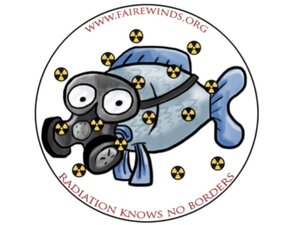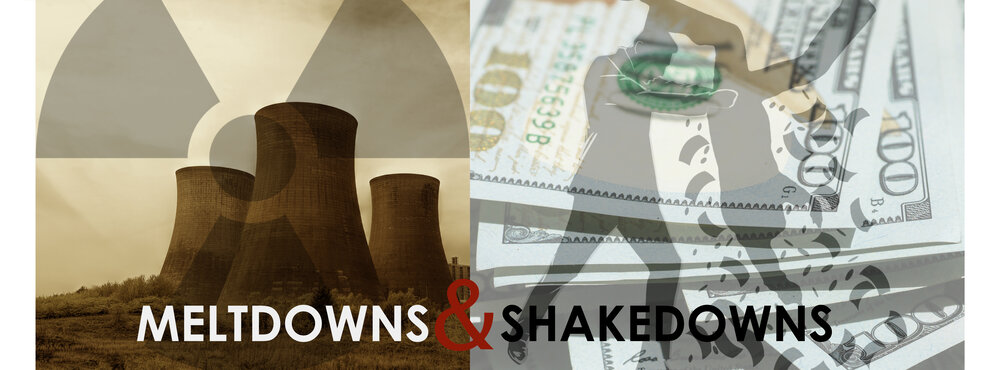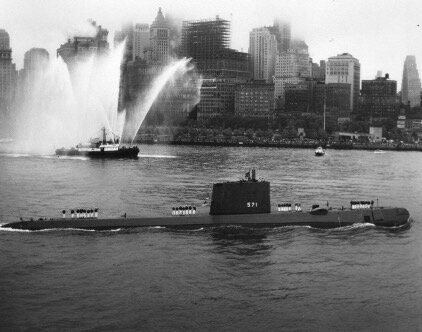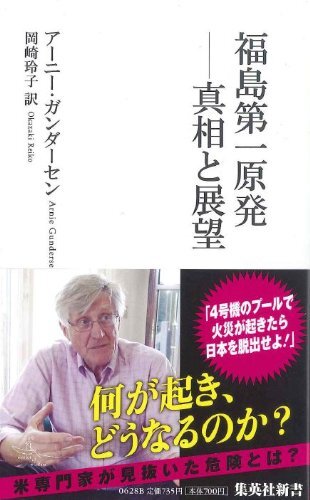
Meltdowns and Shakedowns: Our Nuclear Legacy - Fairewinds
Posted: 4th October 2021
Meltdowns & Shakedowns Series
Meltdowns and Shakedowns: Our Nuclear Legacy
By The Fairewinds Crew
Compared to renewable energy, creating electricity by splitting atoms is simply uneconomical in today’s energy market. Honestly, using atomic power to generate electricity never was economical! Factoring in external costs, like storing the nuclear power and atomic bomb waste for 250,000 years and attempting to corral and clean up migrating radioactive isotopes, proves how impossible it ever was to produce electricity via nuclear power. So rather than being “too cheap to meter” as the industry marketed itself and the 20th-century solution to affordable energy around the world, electricity generated by atoms was and always will be a marketing ploy to assuage the sin of building atomic bombs.
Today, at Fairewinds Energy Education, we begin a new series entitled Meltdowns and Shakedowns. We will look at the financial failures of atomic power plants and other nuclear projects, labs, and facilities and the health risks the nuke industries and government regulators force Americans to live with. Furthermore, recent federal indictments prove how utility executives use marketing ploys and employment bait to grab atomic power subsidies by threatening poor, black, Hispanic, and indigenous communities with plant closures. This use of marketing ploys and employment bait to relax regulations and increase graft is radioactive racism.
We currently live in South Carolina, where courts indicted two utility executives and two Westinghouse executives for covering up massive cost overruns at the uncompleted VC Summer AP1000 reactors. As a result, S.C. utility executives stuck ratepayers with a $9 Billion hole in the ground that will charge higher electric rates for decades to come! In 2010, Fairewinds’ chief engineer Arnie Gundersen spoke to Nuclear Regulatory Commission Advisors at ACRS [Advisory Committee on Reactor Safeguards] about the overwhelming design flaws in the AP1000, when these S.C. reactors and the Vogtle AP1000s in Georgia were just on the drawing boards. As this series proceeds, we will tell you more about Ohio and Illinois, where courts have indicted other executives for similar grifting, as well as Georgia’s ongoing schemes at Vogtle!
However, before we cover those issues, we will start at the beginning of the nuclear and atomic power boondoggle. Almost 100 years ago, the U.S. Government sowed the seeds for the cult of secrecy that led directly to the atomic/nuclear regulations we supposedly have in place today. Some journalists and historians would say that slowly, over time, the Nuclear Regulatory Commission became what they call a Captured Regulator – meaning that the industry it is supposedly regulating is pulling the regulatory strings. At Fairewinds, we see it differently.
To be a captured regulator presupposes that the regulator was at some point in time genuinely independent.
Spoiler alert! In the presentation below, Fairewinds’ board member Arnie Gundersen shows us that the U.S. Government kept atomic power regulation connected to the government’s bomb makers and the military-industrial complex as a way to keep those atoms flowing for nuclear weapons. As a result, the U.S. Government and its cronies grabbed this new method of war with both fists. Whether you call generating electricity using atoms – either atomic power or nuclear power – atoms are the cornerstone of the most devastating form of warfare humanity has ever known. At Fairewinds, we call it Regulatory Collusion!
From the historical perspective of the birth of atomic power until the indictments and graft we see today, this post is laced with anecdotes from Arnie’s 50-year atomic power career. As a kick-off to this series, we have transcribed Arnie’s original Austrian presentation below. It’s an eye-opener!
Compared to renewable energy, creating electricity by splitting atoms is simply uneconomical in today’s energy market. Honestly, using atomic power to generate electricity never was economical! Factoring in external costs, like storing the nuclear power and atomic bomb waste for 250,000 years and attempting to corral and clean up migrating radioactive isotopes, proves how impossible it ever was to produce electricity via nuclear power. So rather than being “too cheap to meter” as the industry marketed itself and the 20th-century solution to affordable energy around the world, electricity generated by atoms was and always will be a marketing ploy to assuage the sin of building atomic bombs.
Today, at Fairewinds Energy Education, we begin a new series entitled Meltdowns and Shakedowns. We will look at the financial failures of atomic power plants and other nuclear projects, labs, and facilities and the health risks the nuke industries and government regulators force Americans to live with. Furthermore, recent federal indictments prove how utility executives use marketing ploys and employment bait to grab atomic power subsidies by threatening poor, black, Hispanic, and indigenous communities with plant closures. This use of marketing ploys and employment bait to relax regulations and increase graft is radioactive racism.
We currently live in South Carolina, where courts indicted two utility executives and two Westinghouse executives for covering up massive cost overruns at the uncompleted VC Summer AP1000 reactors. As a result, S.C. utility executives stuck ratepayers with a $9 Billion hole in the ground that will charge higher electric rates for decades to come! In 2010, Fairewinds’ chief engineer Arnie Gundersen spoke to Nuclear Regulatory Commission Advisors at ACRS [Advisory Committee on Reactor Safeguards] about the overwhelming design flaws in the AP1000, when these S.C. reactors and the Vogtle AP1000s in Georgia were just on the drawing boards. As this series proceeds, we will tell you more about Ohio and Illinois, where courts have indicted other executives for similar grifting, as well as Georgia’s ongoing schemes at Vogtle!
However, before we cover those issues, we will start at the beginning of the nuclear and atomic power boondoggle. Almost 100 years ago, the U.S. Government sowed the seeds for the cult of secrecy that led directly to the atomic/nuclear regulations we supposedly have in place today. Some journalists and historians would say that slowly, over time, the Nuclear Regulatory Commission became what they call a Captured Regulator – meaning that the industry it is supposedly regulating is pulling the regulatory strings. At Fairewinds, we see it differently.
To be a captured regulator presupposes that the regulator was at some point in time genuinely independent.
Spoiler alert! In the presentation below, Fairewinds’ board member Arnie Gundersen shows us that the U.S. Government kept atomic power regulation connected to the government’s bomb makers and the military-industrial complex as a way to keep those atoms flowing for nuclear weapons. As a result, the U.S. Government and its cronies grabbed this new method of war with both fists. Whether you call generating electricity using atoms – either atomic power or nuclear power – atoms are the cornerstone of the most devastating form of warfare humanity has ever known. At Fairewinds, we call it Regulatory Collusion!
From the historical perspective of the birth of atomic power until the indictments and graft we see today, this post is laced with anecdotes from Arnie’s 50-year atomic power career. As a kick-off to this series, we have transcribed Arnie’s original Austrian presentation below. It’s an eye-opener!
Welcome to Meltdowns and Shakedowns: Our Nuclear Legacy!
How to Dismantle an Atomic Lie—taking apart the nuclear falsehoods
By Arnie Gundersen
The Beginning
I am a nuclear engineer and have been for 50-years. I have two Nuclear Engineering degrees, a Nuclear Reactor Operator’s license, and ultimately became a Senior Vice president in the nuclear industry. My journey in atomic power started in 1958 when I was 9-years-old, and my mother took me to New York City to see the Nautilus.
This first nuclear-powered submarine had just crossed under the North Pole between the Pacific Ocean and the Atlantic. I was enthralled by this atomic-powered submarine, and visions of Jules Verne’s tales peppered my dreams where I imagined travel in the Nautilus.
When I attended university at Rensselaer Polytechnic Institute, I chose my study plan as a 20-year-old sophomore. The math behind splitting atoms and controlling them in a nuclear reactor captivated me, so I decided on nuclear engineering. Later in life, at 40-years-old, I knew I had made a colossal mistake. Splitting atoms for nuclear power is rooted in the secrecy surrounding atomic bombs as weapons of mass destruction.
Like many others my age, I learned that dropping the atomic bomb was allegedly necessary to end a terrible war. My generation was lied to and developed beliefs based on that lie. Studying nuclear engineering, I believed that pursuing the “peaceful use of the atom” would help people worldwide and move us away from atomic war.
In 1971, I became a card-carrying member of the nuclear priesthood when I began my career as a licensed nuclear reactor operator.
I progressed to the position of senior vice president during my 20-years of employment with nuclear energy corporations. All that time, I believed, with religious fervor, that by helping to build and operate atomic power reactors, I would be creating power that was “too cheap to meter.” The historic 1973 gasoline shortages and long lines of cars queued at the pumps made it clear to me and hundreds of other engineers that atomic power was the only solution to the “energy shortage.” Therefore, solving this apparent energy shortage was our sole mantra during the 1970s and 80s. Back then, there were no scientific or political discussions connecting fossil fuels to the climate emergency we face today.
Let me begin my story by tracing the roots of atomic power back 100 years.
I am a nuclear engineer and have been for 50-years. I have two Nuclear Engineering degrees, a Nuclear Reactor Operator’s license, and ultimately became a Senior Vice president in the nuclear industry. My journey in atomic power started in 1958 when I was 9-years-old, and my mother took me to New York City to see the Nautilus.
This first nuclear-powered submarine had just crossed under the North Pole between the Pacific Ocean and the Atlantic. I was enthralled by this atomic-powered submarine, and visions of Jules Verne’s tales peppered my dreams where I imagined travel in the Nautilus.
When I attended university at Rensselaer Polytechnic Institute, I chose my study plan as a 20-year-old sophomore. The math behind splitting atoms and controlling them in a nuclear reactor captivated me, so I decided on nuclear engineering. Later in life, at 40-years-old, I knew I had made a colossal mistake. Splitting atoms for nuclear power is rooted in the secrecy surrounding atomic bombs as weapons of mass destruction.
Like many others my age, I learned that dropping the atomic bomb was allegedly necessary to end a terrible war. My generation was lied to and developed beliefs based on that lie. Studying nuclear engineering, I believed that pursuing the “peaceful use of the atom” would help people worldwide and move us away from atomic war.
In 1971, I became a card-carrying member of the nuclear priesthood when I began my career as a licensed nuclear reactor operator.
I progressed to the position of senior vice president during my 20-years of employment with nuclear energy corporations. All that time, I believed, with religious fervor, that by helping to build and operate atomic power reactors, I would be creating power that was “too cheap to meter.” The historic 1973 gasoline shortages and long lines of cars queued at the pumps made it clear to me and hundreds of other engineers that atomic power was the only solution to the “energy shortage.” Therefore, solving this apparent energy shortage was our sole mantra during the 1970s and 80s. Back then, there were no scientific or political discussions connecting fossil fuels to the climate emergency we face today.
Let me begin my story by tracing the roots of atomic power back 100 years.
The Historical Perspective
With so much to discuss today, I will share only a few critical historical aspects that presently influence atomic safety. In my story and personal awakening, I will also weave in my journey as a nuclear whistleblower that began in 1990. Atomic regulation has not and will never protect citizens of our planet. Quite honestly, Regulatory Capture of nuclear power, a term I have used frequently, never existed. Instead, Regulatory Collusion created nuclear power.
More than 100 years ago, from the late 1890s through 1938, was an exciting period for scientific growth in humankind’s understanding of the atom. During those 40 years, humankind discovered the atomic nucleus with orbiting electrons, something we take for granted today. The concepts of the Theory of Relativity, Quantum Mechanics, the Uncertainty Principle, and Radioactivity were discovered and freely discussed in scientific literature worldwide.
On the political side, while science moved forward, politics moved backward: World War I began and ended. Adolf Hitler and the Nazis rose to power in Germany, and the persecution of the Jewish people had already begun.
In 1938, Otto Hann bombarded uranium with neutrons, yet he did not understand the test results. The female scientist Lise Meitner and her nephew Otto Frisch reviewed Hann’s data and concluded that the uranium atom had split into two parts when hit by a neutron. Meitner was the first scientist to understand and calculate the enormous amount of energy produced when uranium atoms split. She calculated that one atom undergoing fission created one million times more energy than one atom undergoing a chemical reaction. Indeed, she and her nephew created the word FISSION.
Meitner was the first scientist to grasp that a new primordial force of nature had been discovered. As an aside, Otto Hann received a Noble Prize for his chemical analysis of fission. The Noble Committee made no mention of Meitner’s discoveries, naming fission, or other theoretical contributions. Unlike Hann who worked on the German bomb program, Meitner left Germany and refused to work on any atomic bomb program.
Almost immediately, scientists in the U.S., Western Europe, and Russia were enthralled with the power created by splitting uranium atoms and had no recognition of its toxic radioactive byproducts. The scientists focused on the heat produced from the fission (the bright spot at the center) and not the radioactive rubble called fission products left behind.
View fullsize
German and Western scientists realized they were dealing with a primordial force of the Universe. When these discoveries became Top Secret, the U.S. Government eliminated the process of sharing new scientific discoveries through peer-reviewed papers. Meitner’s ideas rapidly came to America as scientists fled the threat of war in Europe by escaping to the U.S.
A shroud of secrecy was created in the U.S. as the race to develop an atomic bomb began in 1939. Building an atomic bomb from uranium is the only scientific technology founded in secrecy as a Weapon of Mass Destruction – WMD. Dr. Albert Einstein wrote to U.S. President Franklin D. Roosevelt in August 1939, informing the President that the discovery of atomic fission was an opportunity to make bombs more powerful than any weapon ever invented. It stunned me to realize that Einstein wrote to President Roosevelt one month before World War II began in Europe with Germany’s invasion of Poland and two and a half years before the Japanese bombed Pearl Harbor. In his letter, Einstein said:
This new phenomena would also lead to the construction of bombs… that extremely powerful bombs of a new type may thus be created. A single bomb of this type…. might very well destroy a whole port with some of the surrounding territory.
Einstein’s letter to Roosevelt began a shroud of secrecy perpetrated by America’s military in its founding of the U.S. Manhattan Project in December 1942.
View fullsize
Using this newly discovered primeval force of the Universe was never designed to protect people or create electricity. Splitting of the atom and the post-war expansion of atomic energy created Weapons of Mass Destruction – WMDs to obliterate humans.
The Top Secret weapons of mass destruction created by the American Manhattan Project were the single most expensive project in World War II. Initially, scientists believed only uranium was fissionable, but in 1942, scientists created Plutonium, a new element unknown in nature and named for the God of Hell. Plutonium was found to be fissionable and cheaper to produce than enriched uranium. America now had two paths to make WMDs [Weapons of Mass Destruction]. One bomb that used enriched Uranium 235 was dropped on Hiroshima, and the other using Plutonium 239 was dropped on Nagasaki.
View fullsize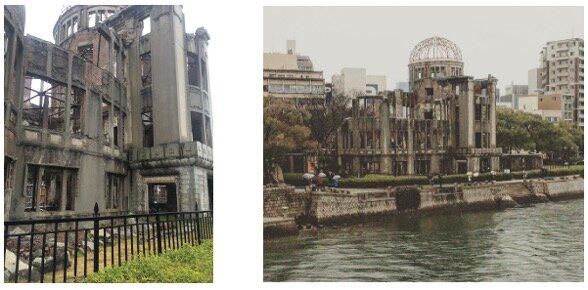
Damage from the 1945 atomic bombing of Hiroshima, Japan is still seen today! Picture taken by Arnie Gundersen
The U.S. Government created the Atomic Energy Commission [AEC] in 1946 to replace military control of the Manhattan Project with atomic power placed under civilian control. However, the AEC maintained the same level of secrecy and used practically all of the same people. Uranium enrichment plants and plutonium production plants continued to produce more bomb-grade material as instructed by President Harry Truman. Bomb manufacturing and testing continued unabated, thus creating enormous amounts of radioactive waste.
These U.S. Weapons of Mass Destruction [WMDs] released primeval forces into the world in 1945 and obliterated 200,000 souls. I visited this shrine to the victims of Hiroshima in 2016. It contains the ashes of 70,000 people.
View fullsize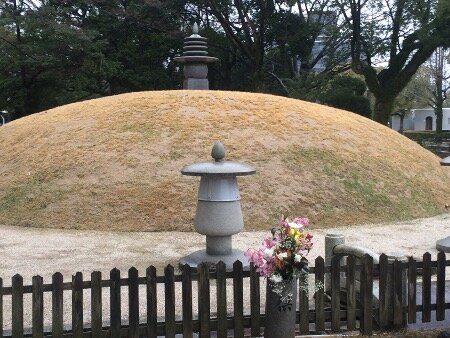
Hiroshima Tomb holding the ashes of 70,000+ Japanese atomic bomb victims. Picture taken by Arnie Gundersen
J Robert Oppenheimer, who is considered the Father of the Atomic Bomb, admitted in 1947 that the physicists who worked on the Manhattan Project could never atone for their sin.
“In some sort of crude sense which no vulgarity, no humour, no overstatements can quite extinguish,” he said two years after the Trinity explosion, “the physicists have known sin; and this is a knowledge which they cannot lose.”
View fullsize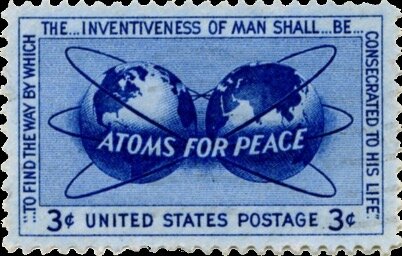
President Dwight D. Eisenhower announced the Atoms for Peace Program in 1953 to solve “the fearful atomic dilemma” by finding some way in which “the miraculous inventiveness of man” “would not be dedicated to his death, but consecrated to his life.” I was surprised by Eisenhower’s use of the word consecrate, which according to the Oxford Dictionary, means “to make or declare sacred; dedicate formally to a religious or divine purpose”.
Please do not underestimate the religious overtones in developing these Weapons of Mass Destruction [WMDs]. In an attempt to atone for this so-called original sin of creating WMDs [Weapons of Mass Destruction], Eisenhower consecrated nuclear fission in the Atoms for Peace program. Yet, the civilian atomic power program used the same people that initially created the A-bomb in secrecy. That is hardly making a fresh start. Even now, a U.S organization called Christians for Nuclear, whose members work inside the nuclear industry, claims:
“We believe that God is the Creator of the Universe, which includes all nuclei, as well as radioactivity and nuclear energy, which we should therefore consider to be His good gifts to mankind. We count it a privilege to be involved professionally in investigating and harnessing this source of God-given energy and making it available to benefit humankind. [Emphasis Added].
Before Eisenhower left office, he appointed Dr. Glenn Seaborg as Chairman of the Atomic Energy Commission [AEC]. Seaborg discovered Plutonium and determined in secrecy that it would cost less to make a plutonium bomb than a uranium bomb. Seaborg was the AEC [Atomic Energy Commission] Chair during the next ten years while atomic bomb construction and nuclear power plant development and construction were at their apex. Yet, during President Eisenhower’s farewell address at the end of his presidency, he warned Americans to beware of the Military-Industrial Complex, a lesson we still have not learned.
View fullsize
And so, against the backdrop of Atoms for Peace, in 1971, I consecrated my career in the atomic priesthood as a newly-minted nuclear engineer in the U.S. atomic power industry. The nuclear industry is enormous, extraordinarily profitable, and with tenacious political and legal contacts with Washington Lobbyists and Law Firms. It shapes the laws that govern it and even controls who Congress appoints to the Nuclear Regulatory Commission to oversee it!
To be accepted into the Atomic Priesthood as I initially was, one must believe in the regulatory Echo Chamber. Regulators and the nuke industry use specific language and jargon, some call it Nukespeak, to frame all nuclear concepts inside a predetermined and agreed-upon box. This predetermined regulatory framework began in 1945 and still exists today anywhere in the world with nuclear power and weapons.
Let’s quickly look at some of its lexica in place in the U.S.:
The industry uses terms like Accident or Incident instead of the underlying terms such as disaster, catastrophe, or meltdown.
During the 1970s, the U.S government dropped the word Atomic. It began to use the word Nuclear and disbanded the Atomic Energy Commission to form the Nuclear Regulatory Commission [NRC]. According to public opinion polls, more people were afraid of the word atomic than nuclear due to their terror over atomic bombs. In contrast, the term nuclear had no such negative connotations and instead is seen as technological advancement.
The entire atomic power industry has agreed upon a regulatory framework and terminology for Design Basis Accident [DBA] and Maximum Credible Accidents [MCAs] that have become the basis for the nuclear power industry’s design calculations. For example, the American designers of Fukushima built an inexpensive 5-meter-high tsunami wall and considered the 5-meter-wall its MCA – Maximum Credible Accident. Unfortunately, the 15-meter-tsunami was not informed of nuclear power industry analyses when it chose to overwhelm the Fukushima Dai-ichi site. Colleagues, who left the nuke industry or outsiders who critique it, actually call MCA – the Maximum Cash Available. The DBA and MCA methodologies allow the construction of inexpensive structures that may be easily overwhelmed by disasters.
For those who were once inside atomic industries and then crossed over to other work or as whistleblowers, each one had an epiphany and realized that this regulatory framework made no sense, that the emperor had no clothes.
Let’s listen to the words of Sergiy Parashyn, an engineer at Chernobyl, about his epiphany:
“We knew, with certainty, with arrogant certainty, that we were in control of the power we were playing with.
This was the day… we learned we were wrong.”
My epiphany occurred in 1990. I was employed with the nuclear industry as a Senior Vice-President. After 20-years in the industry, I believed the NRC was tough and fair until I became a nuclear whistleblower.
1.1. Briefly, I uncovered radiation safety violations at Nuclear Energy Services / NES, my employer. When I tried to have the violations corrected by the company, the corporation’s president fired me for doing my job. Then I went to the Nuclear Regulatory Commission / NRC and was shocked that it would not support me. The NRC deliberately distorted the follow-up investigation of my safety concerns and supported the company I had worked for.
1.2. Three years after I began fighting the NRC, I contacted Senator John Glenn, the former astronaut and my childhood hero. Senator Glenn held whistleblower hearings in which I testified and was commended for my actions, while Senator Glenn lambasted the NRC. Ivan Selin, then the NRC Chair, even told Senator Glenn that I was a hero who performed quite a service to my country. Yet behind the scenes, Selin, a Republican appointee and significant donor to the Republican party, did absolutely nothing, even after the Inspector General’s investigation showed that NRC personnel had purposely lied and covered up my findings.
1.3. After the Glenn hearings, a prominent Nuclear Industry attorney and former colleague told me, “Arnie, in this business, you’re either for us or against us, and you just crossed the line.”
It was then I realized that this NRC leopard would never change its spots. The roots of atomic power regulation date back to the secrecy of creating Weapons of Mass Destruction [WMDs]. While secrecy has blocked public input, the nuclear industry has grown wealthy beyond imagination through intertwined relations among regulators and the military-industrial complex.
Regulatory Capture presupposes that at some point, the regulator has been independent. Instead, I have discovered that regulation of the atomic industry has never been independent and never protected public health and welfare. Long ago, during the 1940s, Nuclear Regulators were not Captured by the military-industrial complex. Instead, Regulators Colluded with it in secrecy.
With so much to discuss today, I will share only a few critical historical aspects that presently influence atomic safety. In my story and personal awakening, I will also weave in my journey as a nuclear whistleblower that began in 1990. Atomic regulation has not and will never protect citizens of our planet. Quite honestly, Regulatory Capture of nuclear power, a term I have used frequently, never existed. Instead, Regulatory Collusion created nuclear power.
More than 100 years ago, from the late 1890s through 1938, was an exciting period for scientific growth in humankind’s understanding of the atom. During those 40 years, humankind discovered the atomic nucleus with orbiting electrons, something we take for granted today. The concepts of the Theory of Relativity, Quantum Mechanics, the Uncertainty Principle, and Radioactivity were discovered and freely discussed in scientific literature worldwide.
On the political side, while science moved forward, politics moved backward: World War I began and ended. Adolf Hitler and the Nazis rose to power in Germany, and the persecution of the Jewish people had already begun.
In 1938, Otto Hann bombarded uranium with neutrons, yet he did not understand the test results. The female scientist Lise Meitner and her nephew Otto Frisch reviewed Hann’s data and concluded that the uranium atom had split into two parts when hit by a neutron. Meitner was the first scientist to understand and calculate the enormous amount of energy produced when uranium atoms split. She calculated that one atom undergoing fission created one million times more energy than one atom undergoing a chemical reaction. Indeed, she and her nephew created the word FISSION.
Meitner was the first scientist to grasp that a new primordial force of nature had been discovered. As an aside, Otto Hann received a Noble Prize for his chemical analysis of fission. The Noble Committee made no mention of Meitner’s discoveries, naming fission, or other theoretical contributions. Unlike Hann who worked on the German bomb program, Meitner left Germany and refused to work on any atomic bomb program.
Almost immediately, scientists in the U.S., Western Europe, and Russia were enthralled with the power created by splitting uranium atoms and had no recognition of its toxic radioactive byproducts. The scientists focused on the heat produced from the fission (the bright spot at the center) and not the radioactive rubble called fission products left behind.

German and Western scientists realized they were dealing with a primordial force of the Universe. When these discoveries became Top Secret, the U.S. Government eliminated the process of sharing new scientific discoveries through peer-reviewed papers. Meitner’s ideas rapidly came to America as scientists fled the threat of war in Europe by escaping to the U.S.
A shroud of secrecy was created in the U.S. as the race to develop an atomic bomb began in 1939. Building an atomic bomb from uranium is the only scientific technology founded in secrecy as a Weapon of Mass Destruction – WMD. Dr. Albert Einstein wrote to U.S. President Franklin D. Roosevelt in August 1939, informing the President that the discovery of atomic fission was an opportunity to make bombs more powerful than any weapon ever invented. It stunned me to realize that Einstein wrote to President Roosevelt one month before World War II began in Europe with Germany’s invasion of Poland and two and a half years before the Japanese bombed Pearl Harbor. In his letter, Einstein said:
This new phenomena would also lead to the construction of bombs… that extremely powerful bombs of a new type may thus be created. A single bomb of this type…. might very well destroy a whole port with some of the surrounding territory.
Einstein’s letter to Roosevelt began a shroud of secrecy perpetrated by America’s military in its founding of the U.S. Manhattan Project in December 1942.

Using this newly discovered primeval force of the Universe was never designed to protect people or create electricity. Splitting of the atom and the post-war expansion of atomic energy created Weapons of Mass Destruction – WMDs to obliterate humans.
The Top Secret weapons of mass destruction created by the American Manhattan Project were the single most expensive project in World War II. Initially, scientists believed only uranium was fissionable, but in 1942, scientists created Plutonium, a new element unknown in nature and named for the God of Hell. Plutonium was found to be fissionable and cheaper to produce than enriched uranium. America now had two paths to make WMDs [Weapons of Mass Destruction]. One bomb that used enriched Uranium 235 was dropped on Hiroshima, and the other using Plutonium 239 was dropped on Nagasaki.

Damage from the 1945 atomic bombing of Hiroshima, Japan is still seen today! Picture taken by Arnie Gundersen
The U.S. Government created the Atomic Energy Commission [AEC] in 1946 to replace military control of the Manhattan Project with atomic power placed under civilian control. However, the AEC maintained the same level of secrecy and used practically all of the same people. Uranium enrichment plants and plutonium production plants continued to produce more bomb-grade material as instructed by President Harry Truman. Bomb manufacturing and testing continued unabated, thus creating enormous amounts of radioactive waste.
These U.S. Weapons of Mass Destruction [WMDs] released primeval forces into the world in 1945 and obliterated 200,000 souls. I visited this shrine to the victims of Hiroshima in 2016. It contains the ashes of 70,000 people.

Hiroshima Tomb holding the ashes of 70,000+ Japanese atomic bomb victims. Picture taken by Arnie Gundersen
J Robert Oppenheimer, who is considered the Father of the Atomic Bomb, admitted in 1947 that the physicists who worked on the Manhattan Project could never atone for their sin.
“In some sort of crude sense which no vulgarity, no humour, no overstatements can quite extinguish,” he said two years after the Trinity explosion, “the physicists have known sin; and this is a knowledge which they cannot lose.”

President Dwight D. Eisenhower announced the Atoms for Peace Program in 1953 to solve “the fearful atomic dilemma” by finding some way in which “the miraculous inventiveness of man” “would not be dedicated to his death, but consecrated to his life.” I was surprised by Eisenhower’s use of the word consecrate, which according to the Oxford Dictionary, means “to make or declare sacred; dedicate formally to a religious or divine purpose”.
Please do not underestimate the religious overtones in developing these Weapons of Mass Destruction [WMDs]. In an attempt to atone for this so-called original sin of creating WMDs [Weapons of Mass Destruction], Eisenhower consecrated nuclear fission in the Atoms for Peace program. Yet, the civilian atomic power program used the same people that initially created the A-bomb in secrecy. That is hardly making a fresh start. Even now, a U.S organization called Christians for Nuclear, whose members work inside the nuclear industry, claims:
“We believe that God is the Creator of the Universe, which includes all nuclei, as well as radioactivity and nuclear energy, which we should therefore consider to be His good gifts to mankind. We count it a privilege to be involved professionally in investigating and harnessing this source of God-given energy and making it available to benefit humankind. [Emphasis Added].
Before Eisenhower left office, he appointed Dr. Glenn Seaborg as Chairman of the Atomic Energy Commission [AEC]. Seaborg discovered Plutonium and determined in secrecy that it would cost less to make a plutonium bomb than a uranium bomb. Seaborg was the AEC [Atomic Energy Commission] Chair during the next ten years while atomic bomb construction and nuclear power plant development and construction were at their apex. Yet, during President Eisenhower’s farewell address at the end of his presidency, he warned Americans to beware of the Military-Industrial Complex, a lesson we still have not learned.

And so, against the backdrop of Atoms for Peace, in 1971, I consecrated my career in the atomic priesthood as a newly-minted nuclear engineer in the U.S. atomic power industry. The nuclear industry is enormous, extraordinarily profitable, and with tenacious political and legal contacts with Washington Lobbyists and Law Firms. It shapes the laws that govern it and even controls who Congress appoints to the Nuclear Regulatory Commission to oversee it!
To be accepted into the Atomic Priesthood as I initially was, one must believe in the regulatory Echo Chamber. Regulators and the nuke industry use specific language and jargon, some call it Nukespeak, to frame all nuclear concepts inside a predetermined and agreed-upon box. This predetermined regulatory framework began in 1945 and still exists today anywhere in the world with nuclear power and weapons.
Let’s quickly look at some of its lexica in place in the U.S.:
The industry uses terms like Accident or Incident instead of the underlying terms such as disaster, catastrophe, or meltdown.
During the 1970s, the U.S government dropped the word Atomic. It began to use the word Nuclear and disbanded the Atomic Energy Commission to form the Nuclear Regulatory Commission [NRC]. According to public opinion polls, more people were afraid of the word atomic than nuclear due to their terror over atomic bombs. In contrast, the term nuclear had no such negative connotations and instead is seen as technological advancement.
The entire atomic power industry has agreed upon a regulatory framework and terminology for Design Basis Accident [DBA] and Maximum Credible Accidents [MCAs] that have become the basis for the nuclear power industry’s design calculations. For example, the American designers of Fukushima built an inexpensive 5-meter-high tsunami wall and considered the 5-meter-wall its MCA – Maximum Credible Accident. Unfortunately, the 15-meter-tsunami was not informed of nuclear power industry analyses when it chose to overwhelm the Fukushima Dai-ichi site. Colleagues, who left the nuke industry or outsiders who critique it, actually call MCA – the Maximum Cash Available. The DBA and MCA methodologies allow the construction of inexpensive structures that may be easily overwhelmed by disasters.
For those who were once inside atomic industries and then crossed over to other work or as whistleblowers, each one had an epiphany and realized that this regulatory framework made no sense, that the emperor had no clothes.
Let’s listen to the words of Sergiy Parashyn, an engineer at Chernobyl, about his epiphany:
“We knew, with certainty, with arrogant certainty, that we were in control of the power we were playing with.
This was the day… we learned we were wrong.”
My epiphany occurred in 1990. I was employed with the nuclear industry as a Senior Vice-President. After 20-years in the industry, I believed the NRC was tough and fair until I became a nuclear whistleblower.
1.1. Briefly, I uncovered radiation safety violations at Nuclear Energy Services / NES, my employer. When I tried to have the violations corrected by the company, the corporation’s president fired me for doing my job. Then I went to the Nuclear Regulatory Commission / NRC and was shocked that it would not support me. The NRC deliberately distorted the follow-up investigation of my safety concerns and supported the company I had worked for.
1.2. Three years after I began fighting the NRC, I contacted Senator John Glenn, the former astronaut and my childhood hero. Senator Glenn held whistleblower hearings in which I testified and was commended for my actions, while Senator Glenn lambasted the NRC. Ivan Selin, then the NRC Chair, even told Senator Glenn that I was a hero who performed quite a service to my country. Yet behind the scenes, Selin, a Republican appointee and significant donor to the Republican party, did absolutely nothing, even after the Inspector General’s investigation showed that NRC personnel had purposely lied and covered up my findings.
1.3. After the Glenn hearings, a prominent Nuclear Industry attorney and former colleague told me, “Arnie, in this business, you’re either for us or against us, and you just crossed the line.”
It was then I realized that this NRC leopard would never change its spots. The roots of atomic power regulation date back to the secrecy of creating Weapons of Mass Destruction [WMDs]. While secrecy has blocked public input, the nuclear industry has grown wealthy beyond imagination through intertwined relations among regulators and the military-industrial complex.
Regulatory Capture presupposes that at some point, the regulator has been independent. Instead, I have discovered that regulation of the atomic industry has never been independent and never protected public health and welfare. Long ago, during the 1940s, Nuclear Regulators were not Captured by the military-industrial complex. Instead, Regulators Colluded with it in secrecy.
In the Nuclear Industry, Regulatory Capture Is Regulatory Collusion
View fullsize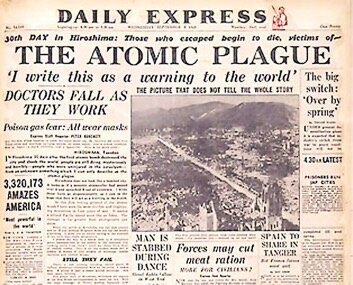
-
The Aftermath of the World War II Atomic Bombs
Immediately after the U.S. dropped atomic bombs on Hiroshima and Nagasaki, the U.S. military swept into Japan. It began its top-secret efforts to prevent the publication of any photographs showing the devastation created by the Atomic Bombs.
-
The Windscale Nuclear Reactor Fire in the U.K. in 1957
In 1988, the New York Times surprised the world with an article about Britain’s Windscale Nuclear Weapons Reactor entitled: Britain Suppressed Details of [1957] ‘57 Atomic Disaster. In 2014 several public advocacy groups concerned about levels of radioactivity caused by Windscale’s 1957 meltdown asked me to travel to the U.K. to speak about the meltdown and the Sellafield Waste Site now located there. Shortly after I arrived, some public officials banned me from speaking at a public venue because my opinions on atomic safety were considered too controversial.
Chernobyl – Manual for Survival, A Chernobyl Guide to the Future, by Dr. Kate Brown of MIT (Massachusetts Institute of Technology), is based on 7-years of research through documents covering the details of the Chernobyl meltdown in Ukraine. The New York Times wrote, “Her villains include not only the lying, negligent Soviet authorities but also the Western governments and international agencies that, in her account, have worked for decades to downplay or conceal the human and ecological cost of nuclear war, nuclear tests, and nuclear accidents.
In 1999, I was invited to the Czech Republic by Hnuti DUHA to testify to Parliament against the start-up of the Temelin Atomic Reactor, Units 1 and 2. After my testimony, the government finally permitted us to inspect the Temelin reactors. Before entering the plant, we were intimidated by a strip search. While we were in the plant, we were further intimidated by four guards with fully automatic AK-47s who followed us everywhere while we inspected the reactor for safety flaws.
-
In March of 2012, Japan’s Diet Commission (the Diet is Japan’s Parliament) released its report on the causes of the triple meltdowns at Fukushima Dai-ichi. Here is a small sampling of what the Commission said:
As Japan pushed nuclear power generation as national policy with the political, bureaucratic, and business circles in perfect coordination, an intricate form of “Regulatory Capture” was created. … Undeniably, this accident was a “manmade disaster” that stemmed from the lack of a sense of responsibility in protecting the lives of the people and the society by present and past government administrations, regulators and TEPCO.
My wife Maggie and I wrote a book in Japanese with barrister Reiko Okazaki about the triple meltdowns at Fukushima. On a speaking tour about the book, I met former Prime Minister Naoto Kan, who told me, “The information I received was neither timely nor accurate”. Such a statement aptly explains the power and arrogance of an industry and its regulators who would so blatantly lie to their own Prime Minister.

-
The Aftermath of the World War II Atomic Bombs
Immediately after the U.S. dropped atomic bombs on Hiroshima and Nagasaki, the U.S. military swept into Japan. It began its top-secret efforts to prevent the publication of any photographs showing the devastation created by the Atomic Bombs.
-
The Windscale Nuclear Reactor Fire in the U.K. in 1957
In 1988, the New York Times surprised the world with an article about Britain’s Windscale Nuclear Weapons Reactor entitled: Britain Suppressed Details of [1957] ‘57 Atomic Disaster. In 2014 several public advocacy groups concerned about levels of radioactivity caused by Windscale’s 1957 meltdown asked me to travel to the U.K. to speak about the meltdown and the Sellafield Waste Site now located there. Shortly after I arrived, some public officials banned me from speaking at a public venue because my opinions on atomic safety were considered too controversial.
Chernobyl – Manual for Survival, A Chernobyl Guide to the Future, by Dr. Kate Brown of MIT (Massachusetts Institute of Technology), is based on 7-years of research through documents covering the details of the Chernobyl meltdown in Ukraine. The New York Times wrote, “Her villains include not only the lying, negligent Soviet authorities but also the Western governments and international agencies that, in her account, have worked for decades to downplay or conceal the human and ecological cost of nuclear war, nuclear tests, and nuclear accidents.
In 1999, I was invited to the Czech Republic by Hnuti DUHA to testify to Parliament against the start-up of the Temelin Atomic Reactor, Units 1 and 2. After my testimony, the government finally permitted us to inspect the Temelin reactors. Before entering the plant, we were intimidated by a strip search. While we were in the plant, we were further intimidated by four guards with fully automatic AK-47s who followed us everywhere while we inspected the reactor for safety flaws.
-
In March of 2012, Japan’s Diet Commission (the Diet is Japan’s Parliament) released its report on the causes of the triple meltdowns at Fukushima Dai-ichi. Here is a small sampling of what the Commission said:
As Japan pushed nuclear power generation as national policy with the political, bureaucratic, and business circles in perfect coordination, an intricate form of “Regulatory Capture” was created. … Undeniably, this accident was a “manmade disaster” that stemmed from the lack of a sense of responsibility in protecting the lives of the people and the society by present and past government administrations, regulators and TEPCO.
My wife Maggie and I wrote a book in Japanese with barrister Reiko Okazaki about the triple meltdowns at Fukushima. On a speaking tour about the book, I met former Prime Minister Naoto Kan, who told me, “The information I received was neither timely nor accurate”. Such a statement aptly explains the power and arrogance of an industry and its regulators who would so blatantly lie to their own Prime Minister.
Conclusion
In Conclusion, with its history based on designing Weapons of Mass Destruction in secret, enormous taxpayer funding, and no public oversight, it is foolish for people around the globe to expect Atomic Regulators to care about public health and welfare.
A leopard cannot change its spots. Let’s look back to the creation of the atomic bomb and understand through history how that WMD mindset created what we have called Regulatory Capture. We now know that from the beginning, it has been Regulatory Collusion.
Fortunately for all of us on this planet, new technologies in the form of renewables – like solar, wind, wave action, and geothermal, battery storage, and conservation are poised to take over our energy economy and end the old atomic paradigm.
View fullsize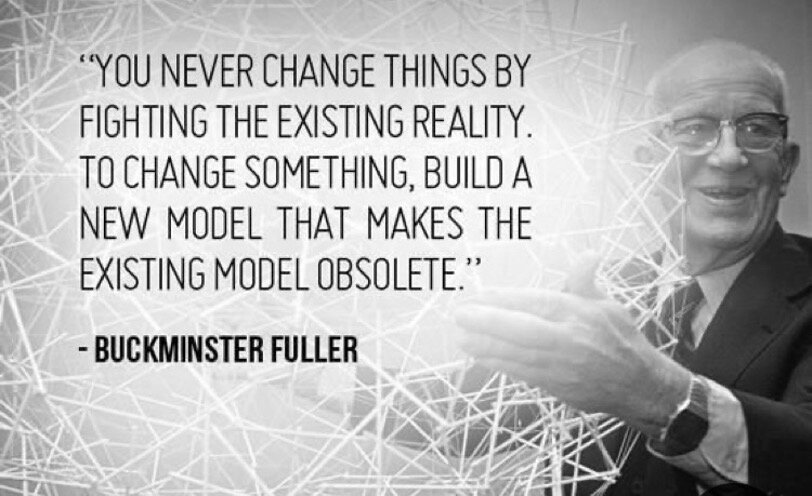
In Conclusion, with its history based on designing Weapons of Mass Destruction in secret, enormous taxpayer funding, and no public oversight, it is foolish for people around the globe to expect Atomic Regulators to care about public health and welfare.
A leopard cannot change its spots. Let’s look back to the creation of the atomic bomb and understand through history how that WMD mindset created what we have called Regulatory Capture. We now know that from the beginning, it has been Regulatory Collusion.
Fortunately for all of us on this planet, new technologies in the form of renewables – like solar, wind, wave action, and geothermal, battery storage, and conservation are poised to take over our energy economy and end the old atomic paradigm.

Fairewinds Will Keep You Informed
